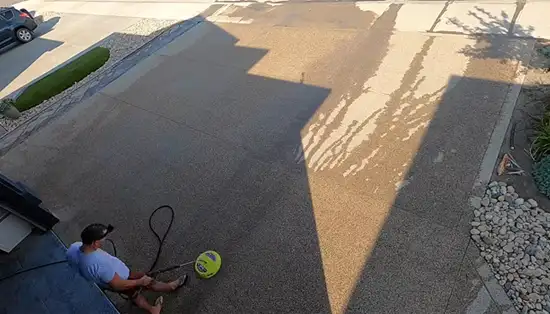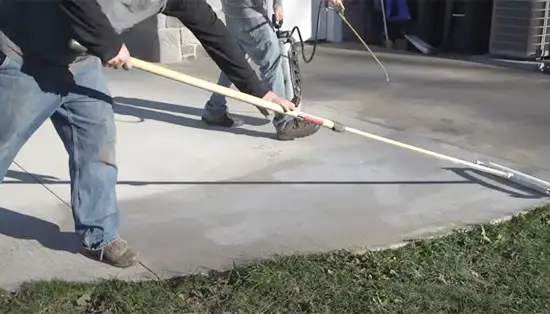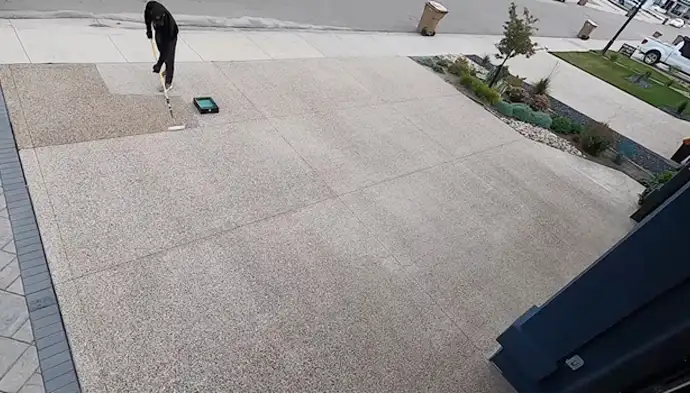Last Updated on January 20, 2023
Power washing and concrete sealing go hand-in-hand when it comes to maintaining, protecting, and restoring your concrete surfaces. Power washing is a quick and effective way to remove dirt, grime, and other stubborn debris that accumulates on the surface of concrete over time.
On the other hand, sealing concrete after power washing is even more important in order to ensure that it stays looking great for years to come. Sealing concrete after power washing not only provides an extra layer of protection against wear and tear, but also brings out the color of your concrete surfaces by providing a vibrant sheen.
In this blog post, we will discuss the benefits of sealing concrete after power washing as well as how you can properly prepare for the job and apply sealant after power washing.
Benefits of Sealing Concrete After Power Washing
Increased Durability and Strength
1. Prevention of Cracking, Spalling, and Pitting – Sealing concrete after power washing is essential for preventing cracking, spalling, and pitting from occurring over time due to exposure to the elements.
The sealant acts as a barrier against moisture and UV rays that can penetrate into your concrete and cause it to deteriorate.
It also prevents dirt, leaves, and other debris from settling into tiny cracks in the surface which can create a breeding ground for mold or mildew growth. This will add extra years of life to your concrete surfaces, making them more durable and strong in the long run.
2. Protection from Sun Damage, Water Damage, and Freeze-Thaw Cycles – By applying a sealant to your concrete after power washing you are providing further protection from sun damage caused by UV radiation which may lead to discoloration or fading of the color over time.
Additionally, sealing provides protection against water damage that can occur when water seeps into small cracks in the surface resulting in staining or erosion of the concrete material itself.
Lastly, freeze-thaw cycles create stress on concrete which can cause cracking or spalling so sealing helps protect against these too by preventing moisture from penetrating through during winter months when temperatures drop below zero degrees Celsius.
Improved Aesthetics
1. Enhances Color and Masking Imperfections – Sealing concrete after power washing will bring out its original color by enhancing its appearance and adding shine if desired with various types of sealants available on the market today including glossy or matte finishes accordingly depending on what you prefer for visual appeal purposes.
In addition, imperfections on the surface such as scratches or discoloration can be concealed with the added protection layer that seals provide making it look like new again!
2. Added Shine or Matte Finish Option for Visual Appeal – Not only does sealing provide protection but it also adds visual appeal with options available such as glossy or matte finishes depending on what look you are going for with your property’s outdoor surfaces whether it be residential or commercial use!
Glossy sealants tend to make surfaces look wet while matte finishes provide a more subtle effect that still enhances color without being overly reflective like its counterpart may be under certain lighting conditions.
Preparation Steps for Sealing Concrete After Power Washing

Removal of All Debris from Surface
Prior to sealing concrete after power washing, it is essential to rid the surface of any debris that can hinder from obtaining a smooth finish and optimal results.
Utilizing a broom or leaf blower can help in removing dirt, dust and other loose particles from the surface. Even after meticulous cleaning, if necessary, use a pressure washer with an appropriate attachment to ensure complete removal of dirt and debris.
Allow Surface to Dry Completely
Once all debris has been removed from the concrete surface, it is important to leave the surface untouched for at least 24 hours before beginning the sealing process.
This allows for adequate drying time ensuring there’s no moisture left on the concrete which could prevent proper adhesion. This is especially crucial during wet or humid weather conditions in order to obtain long-lasting results.
Check Surface for Any Stains or Areas in Need of Repair
Carefully inspect the concrete once it has dried completely for any blemishes or stains that may need to be addressed prior to sealing.
If there are areas that require attention, it is best practice to take care of them at this stage by using an appropriate cleaner specifically designed for concrete surfaces such as TSP (Trisodium Phosphate) mixed with water and a stiff bristle brush.
To restore small cracks or pits in the concrete use a fast-drying patching compound before proceeding with sealing steps.
Application Methods for Sealing Concrete After Power Washing
Using a roller, brush, or airless sprayer to apply the sealant is a great way to preserve the longevity of concrete after power washing. The first step in this process is to calculate an accurate measurement of the square feet to determine how much product will need to be purchased.
Additionally, it is important to consider what type of sealant should be used in order to protect and enhance the look of the concrete surface. Water-based acrylic polymers are often ideal for outdoor applications, as they provide superior resistance against UV light exposure and other wear and tear from the elements.
Some manufacturers may recommend applying multiple coats depending on the condition of the concrete surface when it is power washed.
After application, it is recommended that a beading water test should be conducted prior to applying any additional coats. This test helps ensure that proper coverage has been achieved before continuing with further applications.
Once application has been completed, allow for ample time for curing before walking on the area again; this could range from 24 hours up to several days depending on temperature and humidity levels.
It is also important to check manufacturer guidelines regarding drying times before allowing foot traffic back onto the newly sealed area. Following these steps when sealing concrete after power washing will help protect against damage from moisture infiltration while improving its overall appearance and durability over time.
Is it necessary to seal concrete after power washing?
It is not necessary to seal concrete after power washing, however it can be beneficial for the longevity of the material. Sealing concrete helps protect it from dirt, oil and other contaminants that can damage the surface or penetrate into the material.
By applying an appropriate sealant after powerwashing, you are creating a barrier between the surface of your concrete and these damaging elements. This barrier will help to preserve the appearance and condition of your concrete as well as prevent long-term damage.
How does sealing concrete protect it from the elements?

Sealing concrete protects it from the damaging effects of weather, water, ultraviolet light, salt, stains and other contaminants. When exposed to extreme weather conditions such as freezing temperatures or high heat, moisture can seep into the pores of your concrete and cause cracking or crumbling over time.
Applying a sealant creates a protective layer over your concrete which prevents moisture penetration into its surface. Additionally, sealed concrete is more resistant to staining from oil or grease spills since it acts as an extra layer of protection against these substances.
Does the type of sealant used for sealing concrete after a power wash matter?
Yes, it does matter what type of sealant is used for sealing concrete after a power wash. Different types of sealants are designed for specific uses such as protecting against UV rays or providing waterproofing properties.
It’s important to choose a sealant specifically suited for outdoor use if you’re looking to protect against UV exposure as well as water damage. Additionally, some sealants are also available in multiple colors so they can add aesthetic value while also providing protection from environmental factors.
When is the best time to seal concrete after a power wash?
The best time to seal concrete after a power wash is when the surface is completely dry. Depending on the weather conditions and the amount of moisture left on the surface after the power wash, this could take anywhere from a few hours to a few days.
If you apply sealant while there is still moisture present, it will not adhere properly and can cause damage or discoloration to your concrete. It’s important to wait until the surface is completely dry before applying the sealant.
How long can sealed concrete last before needing another coat of sealant following a power wash?
Properly sealed concrete can last anywhere from one to three years, depending on weather conditions and how much foot traffic it receives. Sun exposure, cold temperatures, and water can all contribute to premature wear and tear of any sealant applied to concrete surfaces.
To maintain optimal protection for your concrete surfaces, it’s best to re-apply sealant every year or two following a power wash. This will help ensure that your outdoor space looks great for many years to come!
In Closing
Sealing concrete after power washing is essential for keeping your decorative surfaces looking their best. Not only does it extend the lifetime of your concrete surfaces but also enhances its appearance with a glossy finish.
However, in order to achieve optimal results from sealing concrete after power washing, proper preparation steps must be taken first. For example, make sure that all traces of dirt and debris are removed before applying any sealant or else you may end up with an uneven result that won’t last very long.
With these tips in mind, you should now have a better understanding of why you should seal concrete after power wash as well as how you can do so correctly.



